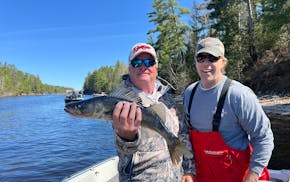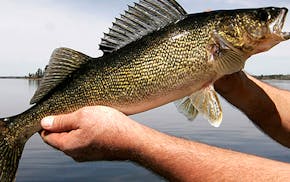Though wildly disparate species, Minnesota ring-necked pheasants and whitetail deer share one important instinct: A fierce, generations-honed will to survive.
That trait has been especially important this winter, when pheasants in southern Minnesota have been pummeled with heavy snow, including this week's blizzard, while whitetails in northern Minnesota, particularly in the northeast, have similarly found themselves up to their kneecaps in white precipitation.
And while the wintertime challenges these two species must overcome to see another spring are in some ways unique — pheasants, for example, must at times evade aerial predators such as hawks, while deer must elude wolves — both are primarily dependent for survival during the cold months on the ready availability of food and protective cover, or habitat.
The prescription for habitat that can help pheasants outlast killer winters is well known: Properly designed complexes of shrubs and other woody cover, along with rows of select evergreen trees, can in many instances help shield ringnecks from wind, snow and predators.
But such habitats are rare in southern Minnesota, particularly those with nearby food sources. More commonly in the state's pheasant range, thick cattail marshes provide security for ringnecks during the critically cold and snowy months of December, January and February.
Attempting to help pheasants survive winter by feeding them is an understandable temptation, said Department of Natural Resources (DNR) South Region Director Scott Roemhildt.
"People love wildlife and want to do something to help,'' he said.
Yet feeding, once begun, must be continued, because pheasants will forgo foraging in favor of easy meals. Feed also must be spread away from roads, where birds can be killed by vehicles. And feed intended for pheasants that is scattered on the ground or, as with corn cobs, contained within wire enclosures, often is consumed quickly by deer.
All of which can make feeding more of a feel-good exercise for people than a benefit to pheasants.
What's more, feeding doesn't boost pheasant populations, research has shown.
"Undisturbed grasslands, or nesting cover, is the number one limiting factor for pheasants,'' said Scott Rall of Worthington, Minn., president of the Nobles County Pheasants Forever chapter. "Thermal winter cover is a distant second. Feeding is perhaps a distant twentieth.''
Better for pheasants, Rall said, are ongoing efforts by the DNR, the U.S. Fish and Wildlife Service, Pheasants Forever chapters and others to acquire and manage large grassland complexes that contain cattail marshes — thus providing both nesting and winter cover.
"If the same amount of energy during winters like this one went into establishing more and better habitat, rather than feeding, the result would be more pheasants,'' Rall said.
Leading up to this week's storm, pheasant losses weren't too bad, Roemhildt believes.
"I've been out on snowshoes quite a bit to see if I could find pheasants lost to the weather, and so far I haven't,'' he said. "During February alone we've increased daylight by an hour, so winter is winding down. If we can get some exposed hillsides due to the sun or wind that would help.''
Deer, meanwhile, particularly up north, often also seek warmth and snow protection in pine, cedar, balsam and other conifer stands. Escape possibilities from wolves also are enhanced in these locations.
Unfortunately, such high-quality coverts, often generally referred to as "deer yards'' in the northern part of the state, are limited, particularly those with browse or other food sources nearby.
What do deer favor?
Glenn Del Giudice was a DNR deer researcher who passed away in December, a month before he was due to retire.
Last year Del Giudice ended a five-year study he hoped would delineate the types of winter cover and food preferred by at least some northern Minnesota deer.
Del Giudice had fitted two groups of whitetails with special GPS collars that sent 207,000 location signals to his computers between 2018 and 2022. When analyzed, the data will help pin down the types of cold-weather habitats deer prefer for food and weather protection.
"Glenn's goal was to come up with a forest prescription for deer to give to wildlife managers for their discussions with foresters,'' said Brad Smith, a researcher who worked with Del Giudice. "Most wildlife managers know by experience the general types of winter cover deer favor. But his study should provide the evidence, so timber cutting could be done that helps not only foresters but deer.''
Many deer to the north historically migrated to deer yards in late fall, but preliminary results from Del Giudice's study indicate fewer migrations occur today, Smith said.
"As more deer survived without migrating, perhaps those migration tendencies weren't passed down to younger deer,'' he said.
As common as certain aspects of their wintertime plights are, deer and pheasants differ in at least one significant way: their reproductive capacities.
Once knocked down due to extreme winters and predation, deer populations in northern climates struggle to quickly rebound. That likely will be the case for some years to come in northeast Minnesota.
Pheasants, on the other hand, can increase their numbers significantly in one, two or three years, provided their June hatching periods are fairly dry.
"We had good pheasant populations last fall because last spring was the first spring in five years we didn't have at least 10 inches of rain just before and just after the peak of the pheasant hatch in late June,'' Rall said.
"The result was good bird numbers and good hunting.''
Anderson: The Chainsaw Sisters Saloon is gone, but the Echo Trail is still a pathway to possibilities

Anderson: Crane Lake gives up its walleyes — and its memories
Anderson: Minnesota's million anglers should be convinced that Boundary Waters is worth protecting

You asked, and we answered our audience's questions about Minnesota's fishing opener.




